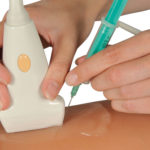Trigger Point Injections
What is a trigger point?
A trigger point is a knotted or tight area of muscle that can be felt under the skin and, when pressure is applied, often refers (or “triggers”) pain to another part of the body.
Trigger points are diagnosed by a thorough physical exam in which the physician palpates muscles for tender areas over taut bands and knots. Imaging tests such as x-rays or MRI cannot detect a trigger point but may be helpful in revealing an underlying condition.
How are trigger point injections administered?


A trigger point injection is done by injecting a solution through a small needle into the troublesome area of the body. The solution is comprised of a local anesthetic that causes the trigger point to become inactive and thus, pain is alleviated.
Injections are given in the office and usually only last a few minutes. The injections can be used to treat various different muscle groups in the body including arms, legs, back, and neck.
Joint Injections
When joint pain does not resolve in a reasonable amount of time with OTC medication and/or physical therapy, an injection of medication directly into the joint is a frequently performed procedure.
What is in a joint injection?
A joint injection typically contains a local anesthetic and a corticosteroid; other joint injections can include hyaluronic acid or biologics. The local anesthetic, similar to what you might receive at the dentist, provides early pain relief, while the steroid suppresses inflammation and decreases swelling for long-term pain relief.
In addition to treating joint pain, the injections are used as a diagnostic tool. The local anesthetic has a numbing effect in the joint, and the amount of immediate pain relief experienced will help confirm or rule out the joint as a source of pain.
How are joint injections administered?


The injection is performed by using ultrasound to guide exactly where the needle needs to go into the affected joint and distributing an anti-inflammatory agent. The most common of these is a corticosteroid. This technique can also be used to remove any excess fluid from around the affected joint.
What can be expected after a joint injection?
After the injection, you may experience immediate but temporary pain relief from the local anesthetic.
Because steroids need a few days to deliver noticeable benefits, there is a chance of the pain returning or even worsening. If the pain worsens, it usually subsides within a day or two. Generally, it’s recommended that you take it easy the day of the procedure, but return to your usual activities the following day. You can ice down the injection site and take an over the counter NSAID, like ibuprofen, for pain relief.
Although joint injections do not change the underlying condition, they can break the cycle of pain and inflammation and allow time for exercise or physical therapy to strengthen muscles and get the joint moving again in order to decrease ongoing problems.
For even longer lasting benefits, Regenerative Therapy treatments, such as Stem Cell Therapy, may be recommended depending on your condition.
For more information and to see if you are a candidate for Trigger Point or Joint Injections, please contact us today to schedule your free initial consultation.
216-313-9044



